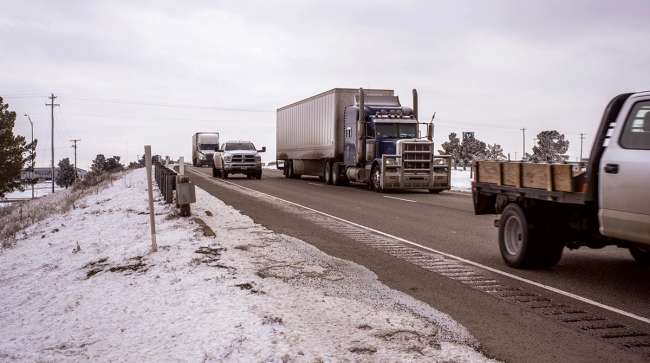Senior Reporter
February Tonnage Takes Winter Weather Hit

[Stay on top of transportation news: Get TTNews in your inbox.]
Severe winter weather took a toll on truck tonnage in February, according to American Trucking Associations.
The ATA For-Hire Truck Tonnage Index for the month declined a seasonally adjusted 5.9% to 110 compared with 119.1 a year ago, and fell 4.5% compared with January. That month, the index measured 115.2.
For purposes of the index, the year 2015 = 100. The index is dominated by contract freight, as opposed to spot market freight.
ATA Chief Economist Bob Costello said the February declines are more an indication of the troubles trucking companies faced during winter storms that hit the country last month than a sign of weak economic conditions.

Costello
“February’s drop was exacerbated — perhaps completely caused — by the severe winter weather that impacted much of the country during the month,” Costello said. “Many other economic indicators were also soft in February due to the bad storms, but I continue to expect a nice climb up for the economy and truck freight as economic stimulus checks are spent, and more people are vaccinated.”
For almost a week in February, large parts of Texas and other southern states battled freezing temperatures, snow and ice that caused severe damage to the Texas power grid and left millions of people without electricity. While the power has been restored, State College, Pa.-based media company AccuWeather Inc. estimates the storm’s total economic damage at $130 billion in Texas alone. That figure is up from its earlier estimate of $50 billion to $60 billion. For the entire nation, it estimates $155 billion in losses. AccuWeather CEO Joel Myers said in a statement that Texas “bore the brunt of the impact,” with lives lost, power outages, water disruptions, burst pipes and, from a business perspective, destroyed citrus crops.
While FedEx Corp. announced record fiscal third-quarter earnings on March 19, the Memphis, Tenn.-based company noted the February weather took a $350 million bite out of its operating income as storms impacted operations at its Memphis headquarters and FedEx Express hubs in North Texas and Indianapolis.
Despite the weather-related challenges, the February Logistics Managers Index showed that February was a strong month for the logistics industry, as the index rose 35.7% year-over-year to 71.4 from 52.6 a year ago. When measured against January’s figure, the index was up 6.25% from 67.2. The number is well above the all-time average of 62.7.
One of the report’s authors, Professor Dale Rogers at Arizona State University, said inventory costs, warehousing prices and transportation prices all reached their highest levels in more than two years. “The high prices are likely due to the long, ongoing runs of warehousing and transportation capacity contraction,” he said in the report. “The combination of tight capacity and high prices are the primary drivers behind the increasing rate of growth detected in this month’s LMI.”
Rogers added he believes the $1.9 trillion federal COVID-19 relief signed by President Joe Biden will propel both the overall economy and the trucking industry to strong performance for the next 18 months.

Even before the pandemic, DHL's Larry S. Onge and Jim Monkmeyer set up strategies and implemented technology in order to respond to disruptions. Now, they know exactly how to get the vaccine from point A to point B — and, better, how to do it at a global scale. Hear a snippet, above, and get the full program by going to RoadSigns.TTNews.com.
“The increased consumer and industrial growth means that the demand for logistics services will continue to grow,” Rogers said. “This poses a challenge as demand for logistics capital like trucks, ships and warehouses increased 2-3 times faster than expected in 2020, leaving supply chains at a deficit with demand far outstripping available supply.”
Rogers added, “After falling by 3.5% in 2020, analysts expect the U.S. GDP will rebound to the tune of 6.6-6.8% in 2021 and 4.3-4.5% in 2022.”
The weekly DAT spot truckload market pricing trends report for the week ending March 21 showed the trucking industry continues to perform at a high level.
National spot load rates in March versus the comparable period in February were up 28 cents per mile for vans at $2.68 a mile. Flatbed rates jumped 17 cents per mile to $2.73 and refrigerated cargo saw a 25-cent per mile jump to $2.94. The report also said flatbed activity has picked up as single home construction is soaring.
A government report released March 17 said building permits in February totaled 1.68 million, 16.6% more than February 2020’s 1.44 million.
Looking forward, Costello told Transport Topics that he is especially optimistic about prospects for the U.S. economy in the second half of 2021. He is forecasting the nation’s gross domestic product will increase by 7%, up from his 5% forecast just a few weeks ago.
“We are going to have some insane growth rates for GDP,” he said.
Want more news? Listen to today's daily briefing below or go here for more info:




